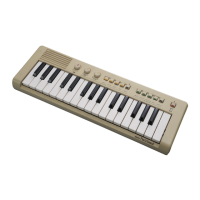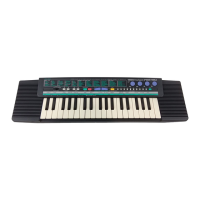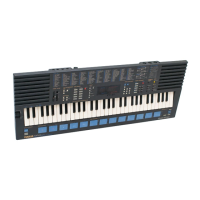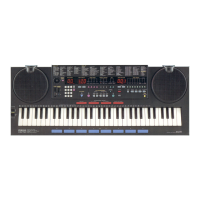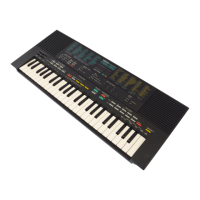Do you have a question about the Yamaha PortaSound PS-3 and is the answer not in the manual?
How to insert batteries, ensuring correct polarity.
Instrument is portable with a built-in speaker for playing anywhere.
Operates using batteries, household current, or car battery.
Offers various preset instrument voices selectable by pressing a selector.
Allows playing up to eight notes simultaneously for polyphonic chords.
Notes linger after key release, enhancing realism for certain voices.
Features four built-in percussive accompaniments: Waltz, Swing, Rock, Latin.
Enables chord/bass patterns with one finger, aiding beginners and players.
Adjusts the overall volume of the instrument.
Adjusts the volume specifically for the Auto Bass Chord section.
Activates automatic bass and chord accompaniment.
Designated keys for triggering automatic bass and chord accompaniment.
Adjusts the volume of the rhythm sections.
Control rhythm tempo and choose among four available rhythm styles.
Starts rhythm automatically with the first key press in ABC section.
Buttons used to select different instrument sounds.
Engages the sustain effect for notes.
Turns the instrument on and off.
Press the power switch; the power-on light will illuminate.
Choose a voice from the Orchestra section by pressing its selector.
Set the overall instrument volume using the control on the far left.
Press a key to hear the selected instrument voice and play a melody.
Press voice selectors; rightmost has priority. Volume via master control.
Adds lingering sound to voices except Vibraphone.
Select a rhythm; priority given to the rightmost selector if multiple are pressed.
Starts rhythm automatically with the first key press in ABC section.
Rhythm starts when a note is played in the Auto Bass Chord section (PS-2/PS-3).
Use Tempo control for speed and Volume control for rhythm level.
Acts as a visual metronome indicating rhythm tempo.
Enables chord/bass/rhythm accompaniment by pressing a single key.
Select rhythm, press Synchro Start, then press ABC keys for accompaniment.
Use the independent Auto Bass Chord Volume control.
Illustrates the key layout for Auto Bass Chord section on PS-2 and PS-3.
Details on creating major, minor, seventh, and minor seventh chords.
Press Single Finger Chord again to cancel ABC and Auto Rhythm.
Connect headphones for private practice without disturbing others.
Connect to Tone Cabinet or stereo system for enhanced sound or recording.
Connects Expression Pedal (EP-1) for foot volume control.
Input for AC adaptor or car battery adaptors.
Details on AC adaptor, car battery adaptors, and YH-series headphones.
Information on Tone Cabinet, Expression Pedal, and connecting cord.
Use correct adaptors; check compatibility and car battery type.
Avoid humidity, sunlight, heat, shocks; store in case.
Clean with damp cloth; turn units off before connecting to stereo.
Details for PS-1: keyboard, voices, rhythms, controls, jacks, speaker, power, dimensions, weight.
Details for PS-2: keyboard, voices, rhythms, controls, jacks, speaker, power, dimensions, weight.
Details for PS-3: keyboard, voices, rhythms, controls, jacks, speaker, power, dimensions, weight.
| Brand | Yamaha |
|---|---|
| Model | PortaSound PS-3 |
| Number of Keys | 49 |
| Voices | 10 |
| Rhythms | 10 |
| Outputs | Headphones |
| Speakers | Yes |
| Power Supply | AC Adapter or Batteries |
| Polyphony | 8 notes |
| Effects | Sustain |
| Power | 9V |
